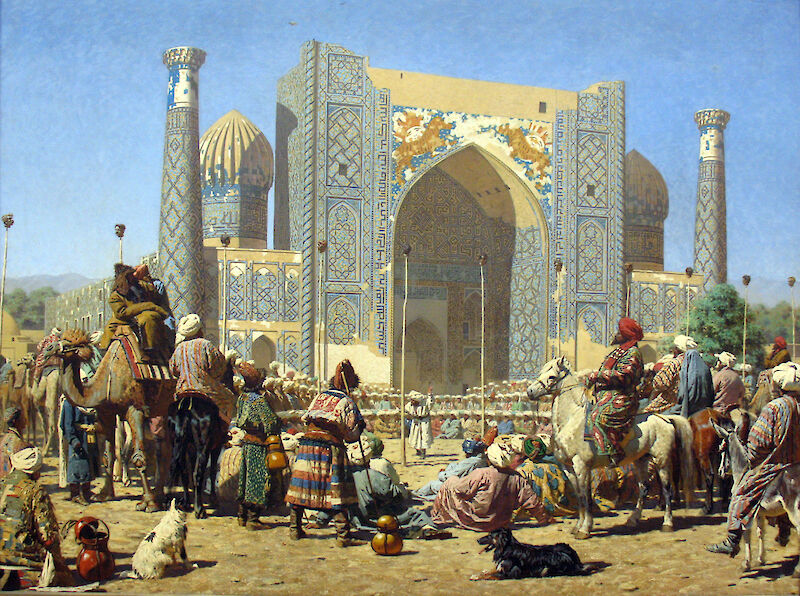


At first glance, Vasily Vasilyevich Vereshchagin’s They are Triumphant feels like a typical large-scale orientalist scene. It’s got the camels, the harsh sunlight and deep shadows, the colorful textiles and pointy beards of a dense crowd arranged in front of one of the monumental iwan gates of the Registan, a public square in the city of Samarkand. But looks closely, and you’ll notice that the row of small dots that stretch across the middle of the canvas are human heads.
In 1867, Vereshchagin was deployed under the command of General Konstantin Kaufman to participate in the conquest of Samarkand, an ancient city in Uzbekistan and a strategic stronghold in Russia’s decades long conquest of Central Asia. Shortly after taking the city in 1868, the bulk of Kaufman’s army left to chase the fleeing Bukharan military, leaving Vereshchagin in charge of 685 mostly injured and non-combatant troops to hold Samarkand. The nearby Bukharan soldiers and anti-Russian tribes seized this opportunity, pooled an army of thousands, and laid siege to Samarkand. It took three days for Kaufman’s army to return and end the siege, and while nearly a third of the garrison had been killed, and the walls of the citadel had been breached in several places, Vereshchagin had held the fort.
General Kaufman gave Vereshchagin his own St. George Cross in gratitude for his service, and the soldiers who survived the siege claimed “if it had not been for Vasily Vasilyevich, we would not have been here anymore.”
Ok, but what’s with the heads on poles? According to a now defunct page on the Tretyakov gallery website, the heads are of Russian soldiers, killed before the fall of Samarkand in 1868, and displayed as a gruesome warning to the invaders. It’s possible these heads greeted Vereshchagin on his first entrance to the city. The artist made at least two other paintings featuring Russian soldier’s disembodied heads in his Barbarians series, picturing the Emir of Bukhara and his allies as brutal, unfeeling adversaries.
The 30-year-old artist seems to be pulling his punches here. It’s propaganda, certainly, as most war art is, but Vereshchagin leaves a surprising amount of emotional distance between the viewer and the violence. So much attention is paid to the Registan tilework, the lazy dogs relaxing in the foreground, and the perfect gradient blue sky. As the Tretyakov article described it “The theme of barbarism does not sound with due force. The artist himself felt this contradiction, writing: ‘I have loved the sun all my life ... the ghost of war still forces me to depict war, and if I want to paint the sun, then I must steal time from myself ...'”
...
Got questions, comments or corrections about They are Triumphant? Join the conversation in our Discord, and if you enjoy content like this, consider becoming a member for exclusive essays, downloadables, and discounts in the Obelisk Store.
